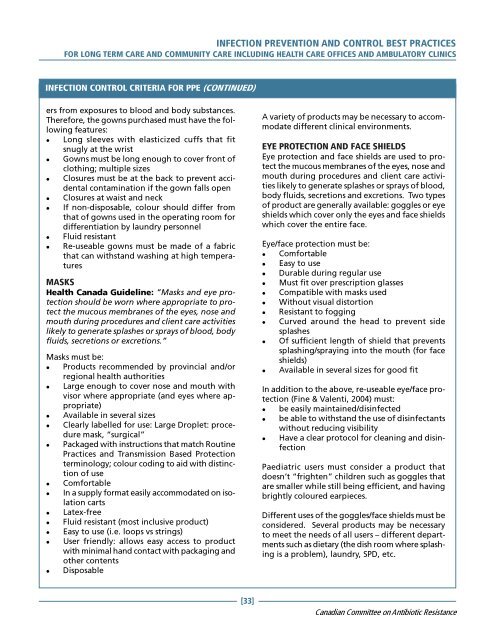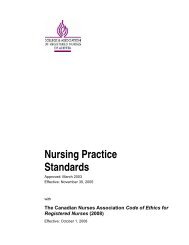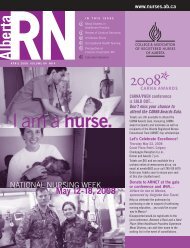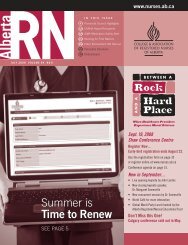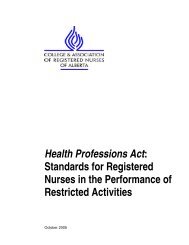Infection Prevention and Control Best Practices - College ...
Infection Prevention and Control Best Practices - College ...
Infection Prevention and Control Best Practices - College ...
You also want an ePaper? Increase the reach of your titles
YUMPU automatically turns print PDFs into web optimized ePapers that Google loves.
INFECTION PREVENTION AND CONTROL BEST PRACTICES<br />
FOR LONG TERM CARE AND COMMUNITY CARE INCLUDING HEALTH CARE OFFICES AND AMBULATORY CLINICS<br />
INFECTION CONTROL CRITERIA FOR PPE (CONTINUED)<br />
ers from exposures to blood <strong>and</strong> body substances.<br />
Therefore, the gowns purchased must have the following<br />
features:<br />
� Long sleeves with elasticized cuffs that fit<br />
snugly at the wrist<br />
� Gowns must be long enough to cover front of<br />
clothing; multiple sizes<br />
� Closures must be at the back to prevent accidental<br />
contamination if the gown falls open<br />
� Closures at waist <strong>and</strong> neck<br />
� If non-disposable, colour should differ from<br />
that of gowns used in the operating room for<br />
differentiation by laundry personnel<br />
� Fluid resistant<br />
� Re-useable gowns must be made of a fabric<br />
that can withst<strong>and</strong> washing at high temperatures<br />
MASKS<br />
Health Canada Guideline: ”Masks <strong>and</strong> eye protection<br />
should be worn where appropriate to protect<br />
the mucous membranes of the eyes, nose <strong>and</strong><br />
mouth during procedures <strong>and</strong> client care activities<br />
likely to generate splashes or sprays of blood, body<br />
fluids, secretions or excretions.”<br />
Masks must be:<br />
� Products recommended by provincial <strong>and</strong>/or<br />
regional health authorities<br />
� Large enough to cover nose <strong>and</strong> mouth with<br />
visor where appropriate (<strong>and</strong> eyes where appropriate)<br />
� Available in several sizes<br />
� Clearly labelled for use: Large Droplet: procedure<br />
mask, “surgical”<br />
� Packaged with instructions that match Routine<br />
<strong>Practices</strong> <strong>and</strong> Transmission Based Protection<br />
terminology; colour coding to aid with distinction<br />
of use<br />
� Comfortable<br />
� In a supply format easily accommodated on isolation<br />
carts<br />
� Latex-free<br />
� Fluid resistant (most inclusive product)<br />
� Easy to use (i.e. loops vs strings)<br />
� User friendly: allows easy access to product<br />
with minimal h<strong>and</strong> contact with packaging <strong>and</strong><br />
other contents<br />
� Disposable<br />
[33]<br />
A variety of products may be necessary to accommodate<br />
different clinical environments.<br />
EYE PROTECTION AND FACE SHIELDS<br />
Eye protection <strong>and</strong> face shields are used to protect<br />
the mucous membranes of the eyes, nose <strong>and</strong><br />
mouth during procedures <strong>and</strong> client care activities<br />
likely to generate splashes or sprays of blood,<br />
body fluids, secretions <strong>and</strong> excretions. Two types<br />
of product are generally available: goggles or eye<br />
shields which cover only the eyes <strong>and</strong> face shields<br />
which cover the entire face.<br />
Eye/face protection must be:<br />
� Comfortable<br />
� Easy to use<br />
� Durable during regular use<br />
� Must fit over prescription glasses<br />
� Compatible with masks used<br />
� Without visual distortion<br />
� Resistant to fogging<br />
� Curved around the head to prevent side<br />
splashes<br />
� Of sufficient length of shield that prevents<br />
splashing/spraying into the mouth (for face<br />
shields)<br />
� Available in several sizes for good fit<br />
In addition to the above, re-useable eye/face protection<br />
(Fine & Valenti, 2004) must:<br />
� be easily maintained/disinfected<br />
� be able to withst<strong>and</strong> the use of disinfectants<br />
without reducing visibility<br />
� Have a clear protocol for cleaning <strong>and</strong> disinfection<br />
Paediatric users must consider a product that<br />
doesn’t “frighten” children such as goggles that<br />
are smaller while still being efficient, <strong>and</strong> having<br />
brightly coloured earpieces.<br />
Different uses of the goggles/face shields must be<br />
considered. Several products may be necessary<br />
to meet the needs of all users – different departments<br />
such as dietary (the dish room where splashing<br />
is a problem), laundry, SPD, etc.<br />
Canadian Committee on Antibiotic Resistance


